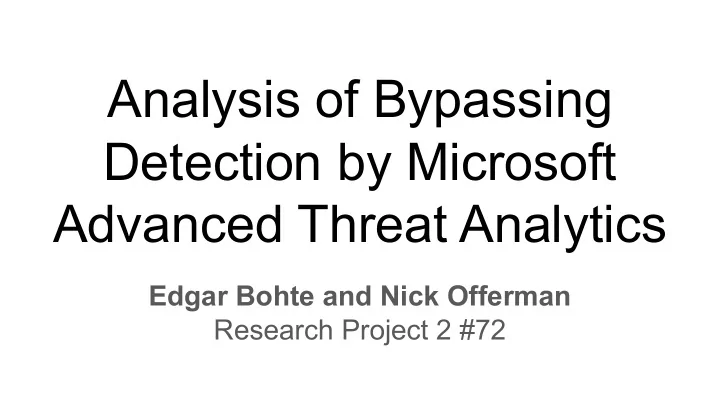

Analysis of Bypassing Detection by Microsoft Advanced Threat Analytics Edgar Bohte and Nick Offerman Research Project 2 #72
Introduction - Advanced Threat Analytics (ATA) ● Microsoft Active Directory (AD) ● On-premise Post-Infiltration detection tool ● Advanced Persistent Threats ● User and Entity Behaviour ○ Anomaly or behavioural analysis ● Advanced monitoring ● Windows, macOS or *nix Operating Systems (OS) 2
Research Context ● Not extensively researched ● Subject an AD test environment to a wide variety of attacks ● Latest version 1.9.2 ● Determine attack triggers ● Bypass detection ● Anomaly-based attacks 3
Relevant research ● Mittal (2017) [1] ○ ATA v1.7 + 1.8 ○ Attacking the Domain Controller (DC) with Lightweight Gateway increases detection ● Thompson (2017) [2] ○ ATA v1.8 ○ Different protocols decreases detection 4
Research questions How can Microsoft Advanced Threat Analytics using anomaly mode be bypassed? ● Which kind of attacks trigger suspicious activity alerts? ● Does the privilege level of the account influence the detection? ● Which particular event in the attack generates the suspicious activity alert? 5
Methods 1. AD environment running ATA 2. Compose a list of categories to index attacks 3. Subject attacks to test environment 4. Examine ATA detections to determine trigger steps 5. Alternative ways to bypass detection 6
Test Environment Setup ● ATA Center ○ analyses traffic ● Lightweight Gateway ○ sends DC1 traffic only ● Client Machines ○ Initial starting point Figure 1: Test Environment 7
Attack Categories ● Discovery ○ network and endpoint knowledge ● Credential Access ○ steal credentials ● Lateral Movement ○ exploit remote endpoint ● Privilege Escalation ○ elevated permissions ● Persistence ○ prevent losing access. 8
Attacking the Test Environment ● Privileged levels Accounts: ● Attack Outcome in Text: ○ Success ○ Domain Administrator ○ Fail ○ ○ Access Denied Domain User + Local Administrator ○ ● Alert Classification in Color: Domain User ○ ○ High Local Administrator ○ Medium ● ~ 85 Attacks ○ Low ○ None ○ Main findings only Domain Admin Success 9 Table 1: Result Example
Discovery Invoke-UserHunter ● Domain admin accounts ● Enumerating repeated sessions Domain Domain User + Domain User Local Admin Admin Local Admin Success Success Success Access Denied Table 2: Detection of ATA for the Invoke-UserHunter command 10
Discovery - detection and bypass Figure 2: Invoke-UserHunter (medium alert) SMB is used to enumerate too many domain users ● Create Domain Userlist (Get-NetUser) ● Include ComputerFile ○ exclude DC with Lightweight Gateway ○ target local machine or DC2 without Lightweight gateway 11
Credential Access ● DCSync ● Simulate the behaviour of DC in order retrieve password via domain replication Targeted user Domain Domain User + Domain User Local Admin Admin Local Admin KRBTGT Success Fail Fail Fail Domain Admin Success Fail Fail Fail Domain User Success Fail Fail Fail Table 4: Detection of ATA for the DCSync attack 12
Credential Access - detection and bypass Figure 3: DCsync High severity Alert ● Detected because a workstation tries to act as a DC ● Bypass by creating a shadow copy of directory using vssadmin.exe. Then get the ntds.dit file. Crack the ntds.dit file and obtain the hashes. 13
Privilege Escalation ● Seven Attacks ● Nothing got detected ○ Partly because most attacks are local 14
Lateral Movement ● Pass The Hash using Cobalt Strike ● Move from one machine or user to another machine or user ● NTLM hash user is needed ● Only accessing the DC1gateway as administrator was detected 15
Lateral Movement - detection and bypass Figure 4: ATA alert creating reverse shell ● Detected because cobalt strike return shell ● Currently working on finding a bypass 16
Persistence ● Golden ticket ● Complete access to the domain ● KRBTGT NTLM hash, group id, security identifier current user Domain Domain User + Domain User Local Admin Admin Local Admin Success Success Fail Success Table 5: ATA alerts for the golden ticket attack for all tested privileges levels 17
Persistence - detection and bypass Figure 5: ATA golden ticket alert ● If the golden ticket is used too long in use. Depends on the security policy of the AD ● Create a new ticket before this time 18
Overview performed attacks Category Total performed Total detected Discovery 54 17 (32%) Credential access 10 3 (30%) Privilege escalation 7 0 (0%) Lateral movement 7 2 (29%) Persistence 9 4 (45%) Total 87 26 (30%) Table 6: Overview of all performed attacks 19
Overview detections bypassed Category Total performed Total detected Total detected after variants Discovery 54 17 (32%) 4 (7%) Credential access 10 3 (30%) 0 (0%) Privilege escalation 7 0 (0%) 0 (0%) Lateral movement 7 2 (29%) 2 (29%) Persistence 9 4 (45%) 2 (22%) Total 87 26 (30%) 8 (9%) Table 7: Overview attacks after attack variants 20
Discussion ● Many attacks performed after each other could influence detections ○ E.g. user10 enumerated all users 2 times in 10 minutes ● ATA alert seen against all possible ATA alerts ○ 5 out 11 not seen from anomaly based ○ 2 behavioral alerts seen, which need one week learning period 21
Conclusion How can Microsoft Advanced Threat Analytics using anomaly mode be bypassed? ● For Privilege escalation no attacks were detected or categories some attacks. The most attacks were detected for discovery ● Privilege level did not influence the detection, but only the outcome of the attack ● Most alerts were generated because of the use of the protocol or that the lightweight gateway was included in the attack ● Most attack were not detected by ATA and even more alerts were bypassed 22
Future work ● Behavioural analysis ● Larger test environment ● Azure ATP 23
Thanks for your attention 24
Sources ● [1]: https://www.blackhat.com/docs/us-17/thursday/us-17-Mittal-Evading-MicrosoftATA-for-ActiveDirectory-Domination.pdf ● [2]: https://www.blackhat.com/docs/eu-17/materials/eu-17-Thompson-Red-Team-Techniques-For-Evading-Bypassing-And-Dis abling-MS-Advanced-Threat-Protection-And-Advanced-Threat-Analytics.pdf 25
Recommend
More recommend